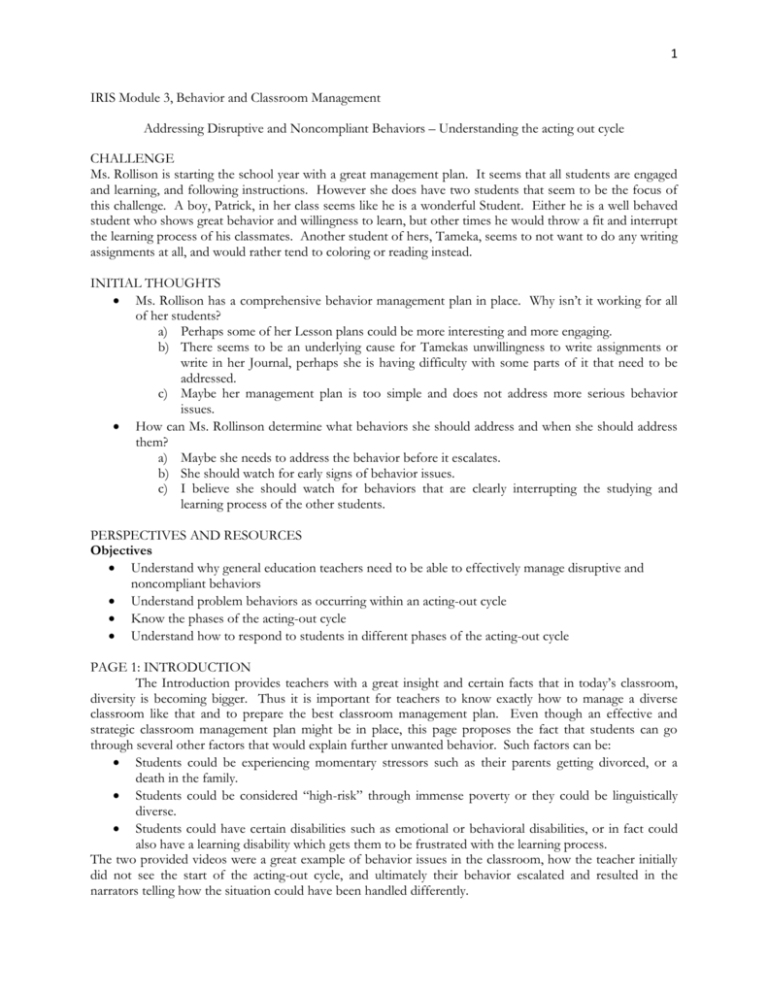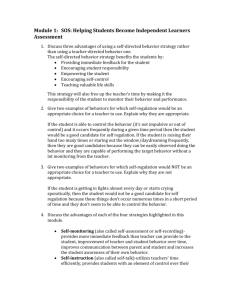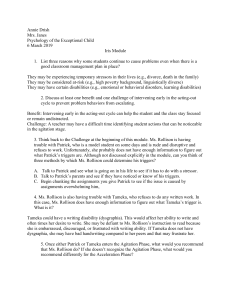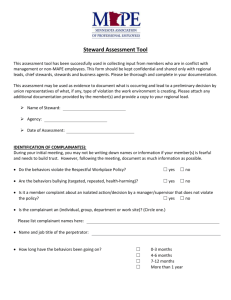Classroom Management: Addressing Disruptive Behaviors
advertisement

1 IRIS Module 3, Behavior and Classroom Management Addressing Disruptive and Noncompliant Behaviors – Understanding the acting out cycle CHALLENGE Ms. Rollison is starting the school year with a great management plan. It seems that all students are engaged and learning, and following instructions. However she does have two students that seem to be the focus of this challenge. A boy, Patrick, in her class seems like he is a wonderful Student. Either he is a well behaved student who shows great behavior and willingness to learn, but other times he would throw a fit and interrupt the learning process of his classmates. Another student of hers, Tameka, seems to not want to do any writing assignments at all, and would rather tend to coloring or reading instead. INITIAL THOUGHTS Ms. Rollison has a comprehensive behavior management plan in place. Why isn’t it working for all of her students? a) Perhaps some of her Lesson plans could be more interesting and more engaging. b) There seems to be an underlying cause for Tamekas unwillingness to write assignments or write in her Journal, perhaps she is having difficulty with some parts of it that need to be addressed. c) Maybe her management plan is too simple and does not address more serious behavior issues. How can Ms. Rollinson determine what behaviors she should address and when she should address them? a) Maybe she needs to address the behavior before it escalates. b) She should watch for early signs of behavior issues. c) I believe she should watch for behaviors that are clearly interrupting the studying and learning process of the other students. PERSPECTIVES AND RESOURCES Objectives Understand why general education teachers need to be able to effectively manage disruptive and noncompliant behaviors Understand problem behaviors as occurring within an acting-out cycle Know the phases of the acting-out cycle Understand how to respond to students in different phases of the acting-out cycle PAGE 1: INTRODUCTION The Introduction provides teachers with a great insight and certain facts that in today’s classroom, diversity is becoming bigger. Thus it is important for teachers to know exactly how to manage a diverse classroom like that and to prepare the best classroom management plan. Even though an effective and strategic classroom management plan might be in place, this page proposes the fact that students can go through several other factors that would explain further unwanted behavior. Such factors can be: Students could be experiencing momentary stressors such as their parents getting divorced, or a death in the family. Students could be considered “high-risk” through immense poverty or they could be linguistically diverse. Students could have certain disabilities such as emotional or behavioral disabilities, or in fact could also have a learning disability which gets them to be frustrated with the learning process. The two provided videos were a great example of behavior issues in the classroom, how the teacher initially did not see the start of the acting-out cycle, and ultimately their behavior escalated and resulted in the narrators telling how the situation could have been handled differently. 2 PAGE 2: OVERVIEW OF THE ACTING-OUT CYCLE The introductory mentions that a lot of times when students result in misbehavior and other such factors, that teachers would assume the behavior came out of nowhere when in fact it must have started at some point. In the provided video, Dr. Kathleen Lane introduces the acting-out cycle, and that this cycle has been proposed by Geoff Colvin and Hill Walker from the University of Oregon; their illustration shows in steps how problem behaviors really do occur. They wanted to show that these behaviors really do tend to start in a chain reaction and thus would explain that students don’t just all of a sudden throw a chair, or yell at the teacher; according to the illustration, they are already at the peak of the unwanted behavior. Dr. Kathleen Lane explains that one way to stop the behavior from escalating is to catch the behavior at its starting stages and to be able to notice that stage. If this is manageable, then students tend to be in a better situation to listen and calm back down. In the video, she provides great information what a teacher can do differently if they notice a student who is struggling. Giving the student a short break in order to be able to cool off seems strategically productive. PAGE 3: PHASE 1-CALM This page tends to explain mostly about what students would be like in the calm-phase; they show willingness to work, learn, and show interest in the subject matter. For teachers it is important and effective to keep students in this phase. This can be established by the following: Creating and providing a well established classroom environment Making sure the students understand the teacher’s classroom behavior expectations. The teacher should make sure the students receive enough attention and clear instructions; if students need more one on one teacher time, they should receive it. Dr. Kathleen Lane explains also that the best discipline is for teachers to have a great lesson plan. In conjunction with a great lesson plan, it is also important for the students to realize that the teacher is also a human being; the teacher can accomplish this by complimenting students in their success, or asking students how they are doing. PAGE 4: PHASE 2-TRIGGERS Quoted from the Module, “If attention is not devoted to maintaining calm behavior, students with behavioral concerns may move out of the Calm Phase and into phase 2 which explain triggers to their behavior” this would explain best that teachers should pay attention to behaviors and address issues before they escalate. Any concerns the student had before and that have not been addressed would now turn into being the trigger to the behavior problem. This page also displays great examples that could have been triggers to student’s later outbursts: School based triggers A negative reaction with the teacher, or argument that did not sit well with the student. Any argument or other conflict with a classmate or friend in the classroom. Any change in the daily routine or schedule. A student not performing well on a task or assignment, and having a negative grade that can be upsetting. A student not understanding a given assignment or task presented in class. Non-school based triggers A student being hungry A student not having had enough sleep Stressful situations at home Medical issues Activity What do you think triggered Mark’s behavior? 3 After viewing the video, I would have assumed that the trigger to Mark’s behavior could have possibly been that the lesson seemed boring to him, or he might not have understood the question or the assignment that was given to him; perhaps he also did not understand the whole subject about what they have done previously that is leading up to him not understanding the assignment. The provided video again explains how important it is for teachers to clarify expectations they have of students in their classroom and teachers can also make sure they assist their students in meeting those expectations. PAGE 5: PHASE 3-AGITATION The agitation phase can take rather longer and can be identified by certain student behaviors such as tapping their hands or darting their eyes around the classroom, moving around the classroom or continuously either stopping or starting their activities. However it is also mentioned that other students would also stare off into space, seclude themselves from conversations, and not get involved in instructional activities; both categories show that the student has officially perhaps stopped being connected to the class routine or learning process entirely. It is important for teachers to be able to identify this stage immediately at its beginning or risk having the students escalating their behaviors. Students that have not been helped thus far before the situation escalates could show verbal or physical aggression. In the provided video, Dr. Kathleen Lane explains that there are several strategies a teacher can focus on with addressing this stage before it progresses to the next phase, such as: The teacher notices the student is having a hard time with a certain task; the teacher could ask the student if he/she needs any help, or inform the student that the teacher is aware the student is struggling, and if there is anything the teacher can do to help. Offer different options for the student at this point, whether it is to take a short break or to work with a partner on the current assignment. If a teacher notices a student having a hard time with a task or assignment, it is usually a good time to perhaps shift the lesson plan or to restructure the assignment task by pairing students to automatically work with a partner so the student with the issue can re-group their thoughts. Sometimes it can also be something the teacher is doing wrong and perhaps he/she needs to regroup her thoughts in structuring the lesson differently to adjust present issues in the classroom. Activity What are some indicators that Mark has entered the Agitation Phase? His body posture and the way he slouches down in his seat shows immediately that he is perhaps already bored with the assignment or the beginning of class. Are any of the other students in the room displaying signs of agitation? The girl in the very front seems to be tapping her pencil several times which could show she is also bored or distracted by Mark’s headshaking. She could also be having a hard time with focusing on the lesson, Is there anything the teacher could have done to intervene at this phase of the cycle? It seems the teacher could have provided a stronger and more engaging lesson plan for her students. PAGE 6: PHASE 4-ACCELERATION As described in the Module, at this point the student would show several behaviors such as questioning, arguing, refusing to do any work, starting to damage or partially destroy small things/property items just so they could possibly gain the teachers attention and overall to get noticed. It has also been mentioned that once in the acceleration stage, either they would tend to the above mentioned factors, or they would work on their assignment but perform very poorly with it, or only finish it half way through. Interesting for me to learn is the fact that it has been recorded that teachers would often detect the occurring situation only at this point, which tends to be rather late since the student has already been in this stage for a longer period of time. In the video, it was talked about what the teacher can do to tackle the Acceleration stage without sending the student over the 4 edge; Offer a prompt, redirect the student, and walk away to give the student time. If the teacher responds to the argument, they will push the student with the problem over the edge. Activity How did the teacher stop Mark’s progression through the acting-out cycle? The teacher did exactly what the above video proposed to do. Instead of engaging in the argument with Mark, she offered a prompt, redirected Mark to try answering number one and let her see it; after she saw it and said it was correct, she let him check another student’s answers which probably made him feel important, understood, and smarter than what he initially thought when he started the task with a frustration. What did she do after stopping his inappropriate behavior? The teacher re-directed his thoughts. She gave him a prompt and was able to get Mark to switch thoughts, then she walked away to let him respond to the new prompt. PAGE 7: PHASE 5-PEAK Supposedly at this stage, it would be considered too late for teachers to successfully intervene and prevent the behavior from escalating, and one would have to simply deal with the behavior. Some of the behaviors associated with this phase, are: Students could focus on physically assaulting their classmates and peers Students with this peak behavior could hurt themselves Students could destroy school property or the property of their classmates Students could also start crying hysterically to show their frustration Behavior in this state is considered to be very loud, but the lasting of this phase tends to be shorter. The Teacher, according to Dr. Kathleen Lane, should always make sure that students are safe in a situation like that. The teacher should know what the procedures are according to the school in responding with a behavior problem that is in the Peak phase. She also mentions that the downfall with a routine response to a behavior problem is that we are teaching that student that if you act out, you get to leave the classroom-and have accompanying consequences. She stressed the importance of having a plan available for behavior problems, and strategies to deal with the behavior issues accordingly, and also in the process making sure to keep all students safe and be able to re-introduce the lesson. PAGE 8: PHASE 6-DE-ESCALATION The de-escalation phase often shows students being confused right after going through the Peak phase. Students would show confusion, disorientation, and their frustration and agitation would be far less severe and settling down. At this point, students would deny their involvement in the just recent behavior issue, and sometimes would try to blame their peers and classmates for the recent situation, but could also try to apologize to their peers. Obviously they would want to forget about their humiliating outburst, and oftentimes students would not want to talk about their recently occurring behavior, and to rather forget it ever happened; in the meanwhile these students would respond again to new instructions and directions. Dr. Kathleen Lane proposes several great pointers a teacher can do with students in the de-escalation phase without humiliating the students in front of the classroom; The students could quietly start on a individual task to write about their behavior and what made it escalate, or have them write their spelling words just for a few minutes until the teacher had a chance to re-direct the other students, and then re-introducing the behavior student to the new instruction as well and thus the teacher could introduce the student to the recovery phase. PAGE 9: PHASE 7-RECOVERY Debriefing is mentioned to be a necessary step in the recovery phase simply because students otherwise would assume they got away with their behavior. This page also focused on an error that teachers assume often in this phase, and that is the assumption that they should not talk to students about their behavior just now in fear the behavior might be re-introduced. By tackling this task, teachers could 5 individually confront the student on a one-on-one basis, and let them know you noticed their frustration, but weren’t sure what triggered that. Teachers can calmly talk to students and often times whispering works well since students realize it is only between them and the teacher, and they don’t have to worry about their classmates or peers listening in. By debriefing the class, a teacher should make sure to have the class understand what the circumstances where, and that this was a result to unwanted behavior and can ultimately be avoided. The point in debriefing the class is to have them understand that the situation that just happened with their classmate happened for several reasons, and to make sure the class understands that we have all had days of frustrating moments; peers and classmates should understand the situation in case of later questions. The class may show several emotions and have questions in regards to what just happened with one of their classmates. PAGE 10: PRACTICE WITH THE ACTING-OUT PHASES I was correct with the Activity on this page where I matched up the corresponding Phases to each video segment. I don’t think I would have been able to even watch out or realize the situation when it started before I started this Module. The next video showed how the teacher intervened in time before the student (Travis) had a chance to get frustrated and continue to escalate on the acting-out cycle. She successfully focused in on the Travis once she saw his frustration and his pencil tapping. Then she did a prompt, redirected him to the task, and followed up with him after he checked his answers with a neighbor. WRAP UP Revisiting Initial Thoughts Think back to your initial responses to the following questions. After working through the resources in the module, do you agree with your initial Thoughts? If not, what aspects of your answers would you change? I would only change the last question as I am now aware of the acting out cycle and the corresponding strategies a teacher can use for each stage. Ms. Rollison has a comprehensive behavior management plan in place. Why isn’t it working for all of her students? How can Ms. Rollison determine what behaviors she should address and when she should address them? After this Module she would/should be aware of the acting-out cycle, and thus would understand the individual phases a student could go through in this cycle, and to look out for certain issues or behaviors the students are portraying. ASSESSMENT 1. List three reasons why some students still cause problems even when there is a good classroom management plan in place? Situations at home could be a major cause to some behavior issues such as: o Parents are going through a divorce o Student comes to school hungry o Learning disabilities 2. Discuss at least one benefit and one challenge of intervening early in the acting-out cycle to prevent problem behaviors from escalating. The benefit from intervening early on in the acting out cycle is to prevent the situation from escalating and also preventing the student from becoming too frustrated that could harm the other classmates. A challenge with intervening is to intervene early enough; the teacher could re-direct the lesson, or possibly give the student a prompt and walk away so the student can either calm down and re-focus or to adjust their thoughts. 3. Think back to the Challenge at the beginning of this module. Ms. Rollison is having trouble with Patrick, who is a model student on some days and on others is rude and disruptive and refuses to 6 work. Unfortunately, she probably does not have enough information to figure out what Patrick’s triggers are. Name three methods by which Ms. Rollison could determine his triggers. Ms. Rollison could watch out for trigger signs that start his acting out cycle; She could ask Patrick if he is struggling with anything, or if he is having any trouble at homesuch as not getting enough food, not getting enough sleep, or other facts that would bother him; She could re-direct the lesson and make it more engaging, and if Patrick is having any issues, the teacher could ask him in a quieter tone on a one-on-one basis if he is having any issues with anything. 4. Ms. Rollison is also having trouble with Tameka, who refuses to do any written work. In this case, you do have enough information to figure out what Tameka’s trigger is. What is it? Tameka seems to either be bored with the subject, or have a learning disability that hinders her from being able to work on this task, or she could have trouble with understanding the writing assignment altogether. 5. Once either Patrick or Tameka enters the Agitation Phase, what would you recommend that Ms. Rollison do? If she doesn’t recognize the Agitation Phase, what would you recommend differently for the Acceleration Phase? I would suggest for Ms. Rollison to give them a prompt, re-direct them to the subject or give them a different task, and walk away; she should come back once she sees they are finished with their task. She could talk to them individually, see if they are struggling with anything; she could also give them a chance to leave the classroom by delivering a note or such to the teacher next door for a few minutes so they can adjust again and have a chance to cool down. 6. What is the primary reason that teachers are often reluctant to engage in debriefing during the Recovery Phase? Why is it important to debrief in spite of this reluctance? Teachers are reluctant to engage in debriefing a student during the Recovery Phase, because they worry that by doing so, they could possibly re-introduce the student to their behavior and the cycle could start again. It is important to debrief the student simply because if a teacher would not debrief the student, then the student would feel like they got away with the behavior issue they have shown.







